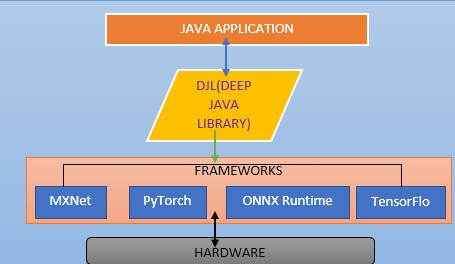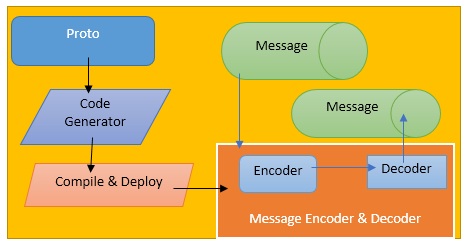Java Contribution in the Areas of Machine Learning and AI Libraries :
As you all know ML and AI is all about data means it's basically taking does in a massive amount of data and starting to make sense and extracting you know useful information to make all kind of decisions but at the end, it is starting with the data and one of the very strong a position that Java as in the big data space it is that virtually you know open-source big data stack or either written in Java or have been written for the JVM and that gives a platform you know these very unique positions and what people want to do with big data and building all sorts of new algorithms starting within a platform that is already running in Java which give Java a significant advantage in the Future of AI and ML.
Java AI Opensource Libraries :
Eclipse Deeplearning4j:
Each Enterprise association’s public or private they are running their apps/platform on Java or they are dealing with some JVM process interaction and the Java process has a colossal environment regarding support libraries and tools that individuals can use to fabricate a wide range of uses. Apache Hadoop, Spark, Kafka, Lucene all are written in java development services or for the JVM as it were.
In most of the leading third or sub-party libraries, there's Eclipse Deeplearning4j which is predominantly utilized widely for deep learnings and contends very well with TensorFlow. Real-time use cases for Deeplearning4j consolidates organization interference discovery and network safety, identification of misrepresentation for the financial area, Anomaly Detection in enterprises like assembling, recommender frameworks in online business, and publicizing and image Recog.
Also, Integration of Deeplearning4j with other types of machine-learning platforms such as RapidMiner, Prediction.io, etc. is been very much useful across many of the organizations.
Deep Java Library: (DJL)
DJL, (Deep Java Library) is nothing but an open-source library developed by Amazon to create & build machine learning(ML) and deep learning models natively in Java intended to be not difficult to begin with and easy to use for Java engineers. DJL gives a bunch of significant level APIs to prepare, test and run derivations.
Java designers can build up their models or use pre-prepared models created by information researcher in Python from their Java code. DJL gives a helpful reflection layer to utilizing the most mainstream AI/ML systems, like Apache MXNet, PyTorch and TensorFlow With the DJL API, you are getting a uniform and reliable layer that can connect with these structures permitting you to trade out your preferred structure with no effect on the customer code.

In the above diagram, the DJL is an abstraction layer. It'll help you to connect to any of the DL framework. Currently it's supported MXNet, PyTorch, ONNX runtime and TensorFlow. So, the top layer is Java application. You can develop the Java applications and it will use the DJL APIs. This is a kind of abstraction layer. Then DJL layer intern connect to the corresponding framework. You can choose which framework you want to use it.
Before even starting the development, you can choose the framework. Then you can go for the development. But whenever required you can switch the framework. So, because of the abstraction layer, there will not be any impact. The DL frameworks or the ML frameworks connect to the hardware. Therefore, you can choose which hardware or services it’s going to interact.
TensorFlow Example:
- TensorFlow provides GradientDescenetOptimizer(GDO). All of the underlying data structures everything that is in a graph that goes across the wire etc. is stored in protobuf format (A Google binary standard for communicating and storage of data/message).
- You can download a Binary of an untrained GradientDescenetOptimizer(GDO) model online.


Usability of TensorFlow in Neural Networks :
-
In TensorFlow, this is modelled as every neuron is a tensor and Wights are sensitivity to each input. And then we have “Biases” which are constants that are added to output. So, there are something like Sharp pains that is sort of taking a short circuit to the brain and that are sort of more like Biases.
![ai ml java 3]()
- As an artificial neuron that gets in a set of inputs and then it weights them and it has a bias that it uses to feed to what's behind it. Notice I said what’s behind it because nothing is ever this simple in the real world. You can have a case where you have a set of neurons for all of your inputs and then immediately behind that is a set of neurons just for your outputs which are the possible outcomes.
- So if we continue on with the Health Survey example let's think of the outputs as like you know perfect health, diabetes, cancer you know different things obesity different things that can happen is a real result of different health decisions, but in actuality it turns out that if you just have those two levels you don't get as much accuracy as you’re likely to want.
- The most common model that you see is a Convolutional neural network that has layers of neurons (tensors) in between the inputs and the outputs and what these neurons are responsible for doing is looking at the data in different kinds of aggregations and they evolve their aggregations over the course of different training data also.
- One aggregation of that is your sense of touch right and then you've got neurons in your eyes that are specialists in everything, but they aggregate as a sense of vision. In TensorFlow the best example is with image recognition you can create a neural network that just has neurons for each of the pixels and then an output which says this is a mammal or this is a fish
Primary Highlights of DJL( Key Features):
Opensource Nature: The first is clearly the profound Java library is an open-source library. Thus, you can see those subtleties on web. It will show you all the upheld, structures, PyTorch, TensorFlow, and, MXNet and each one of those subtleties. The open-source nature of DJL suits commonly advantageous for the tool compartment and its clients
Development Easy framework: Now the subsequent one is engineers can fabricate, prepare and convey, AI, and profound learning models. Utilizing Java and their number one IDE, you can utilize, any of your #1 IDE to build up the models and train them. DJL improves on the utilization of profound learning systems and it as of now upholds Apache MXNet, PyTorch. Furthermore, the TensorFlow. This is a reflection layer. Thus, you can switch the systems at whatever point you needed.
Configuration Friendly: DJL can likewise be arranged with a various hidden motors. So at whatever point is required, you can switch that. It can associate with any of the motors, upheld motors. Thus, utilize local Java ideas and unique away the intricacy associated with profound learning. DJL will utilize the local Java idea and it will give a theoretical layer. Also, you are disconnected from the structure intricacies.
Write once Run Any Where: DJL is engine agnostic, which implies designers can compose code once and run it on any motor. Along these lines, you can compose it or turn it over with one motor and afterward you can change to various motor. So clearly this is a Java usefulness device, as to compose once and run anyplace. Along these lines, it will follow a similar example. So at any rate Java engineers ought to have the fundamental comprehension of machine learning solutions and regular ML terms prior to endeavoring to utilize the DJL.
Auto Hardware configurations Provider: To guarantee the best exhibition, DJL likewise gives Automatic CPU, GPU decisions dependent on equipment design. Along these lines, it will naturally pick since, it's sort of a framework subordinate, and however it will assist you with consequently recognizing which CPU, GPU you are running in. In light of that, it will work. And furthermore, DJL offers an archive of pre-prepared models in our ModelZoo. Designers will actually want to utilize that for their venture
- DJL Core API
- DJL DataSet API
- DJL Basic ModelZoo
- MXNet ModelZoo
- TensorFlow ModelZoo
- TensorFlow Engine for DJL
- PyTorch ModelZoo
Equipment Scheduling: Other use cases, for example, hardware booking where we need to appoint things like beds in medical clinics to patients and with this you can improve the use of those things which could likewise be things like scanners, X-beam sensors or other gear
Vehicle Routing: Vehicle another case you can handle is vehicle directing this is likely the most fascinating or if nothing else the most productive case this is the situation where we have clients setting aside a huge load of cash and a huge load of co2 discharges and that is basically by decreasing the driving time. You've seen driving time decreases of twenty or 25 percent which as you can envision on an armada of a huge number of vehicles has an immense effect on profitability and fuel and fossil fuel byproducts and things like that.
Use Case Implementation (with Java AI Libraries):
Timetabling for Students:

- Here, we have used QUARKUS platform and we can expose a rest service and using QUARKUS. Then here we have to use the extensions of REST Easy to expose microservices.
- Here, we have to use OptaPlanner to optimize and to find that optimal or near optimal timetable and we have used hibernate dihybrid extension to store all that data into a normal relational database.
- Of course, if you build this yourself you might want to replace certain aspects of this instead of a rest service you might want to look at JMS at pulling from a JMS Queue.
- Instead of a relational database you might want to swap that out to hibernate or Mongo DB to connect to NOSQL databases.
Read More: Best Python IDEs for 2025




